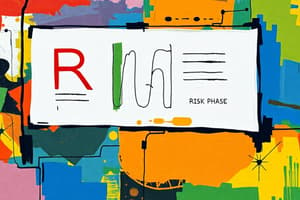Podcast
Questions and Answers
What is a characteristic of risk management in traditional projects according to the text?
What is a characteristic of risk management in traditional projects according to the text?
- High responsiveness to changes
- Short development cycles
- Testing at the end of the project (correct)
- Business people involvement in the project
In traditional projects, what can increase individual project risk?
In traditional projects, what can increase individual project risk?
- Less responsive to changes due to change management processes
- Prescribed comprehensive processes to identify risks (correct)
- Short development cycles
- Quick delivery of increments
Which factor is not categorized as a source of risk by Alan Moran?
Which factor is not categorized as a source of risk by Alan Moran?
- Technical
- Testing (correct)
- Requirements
- Supplier
What is a common characteristic of risk management in agile projects?
What is a common characteristic of risk management in agile projects?
Which type of projects may fail due to ineffective change management?
Which type of projects may fail due to ineffective change management?
What is a key difference in risk management processes between traditional and agile projects?
What is a key difference in risk management processes between traditional and agile projects?
Who is accountable for effective risk management and ensuring all risks have owners?
Who is accountable for effective risk management and ensuring all risks have owners?
What should the Solution Development Team do regarding risks and mitigation?
What should the Solution Development Team do regarding risks and mitigation?
What is a key area of risk for DSDM related to Team skills, ability, and availability?
What is a key area of risk for DSDM related to Team skills, ability, and availability?
What should be done at the end of a Timebox regarding relevant risks?
What should be done at the end of a Timebox regarding relevant risks?
Which role 'owns' the risk of the project not delivering?
Which role 'owns' the risk of the project not delivering?
What should be avoided when completing the Project Approach Questionnaire (PAQ) to identify risks to DSDM process?
What should be avoided when completing the Project Approach Questionnaire (PAQ) to identify risks to DSDM process?
What is the main motivation for project risk management?
What is the main motivation for project risk management?
What are some risks associated with Agile projects?
What are some risks associated with Agile projects?
What is a risk associated with having a small Development Team in Agile projects?
What is a risk associated with having a small Development Team in Agile projects?
Which of the following is a common risk in projects related to supplier failure?
Which of the following is a common risk in projects related to supplier failure?
What is a common risk related to technical issues in projects?
What is a common risk related to technical issues in projects?
What does the statement, 'Successful Agile is about preparing as much as possible in the early stages,' emphasize?
What does the statement, 'Successful Agile is about preparing as much as possible in the early stages,' emphasize?
Flashcards are hidden until you start studying
Study Notes
Project Risk Management
- The main motivation for project risk management is to ensure a successful project outcome and reap greater benefits by having the confidence to manage risks associated with more creative solutions.
- Project risk is defined as the exposure of stakeholders to the consequences of variations in outcome.
Risks in Agile Projects
- Agile projects address some of the key risks encountered in traditional projects, such as missed deadlines and changing requirements.
- Agile projects introduce other risks, including:
- Dependence on full business involvement
- Small Development Team (loss of team members could cause problems)
- Supplier failure
- Technical issues
- Successful Agile is about preparing as much as possible in the early stages, being clear on where risks lie, and how they can be managed.
Risk Management Process
- A simple risk management process involves identifying risks, assessing risks, and addressing risks to achieve project objectives.
- Key areas of risk for DSDM include:
- Level of business involvement and commitment
- Team skills, ability, and availability
- Clarity of vision without defining detail too early
- Focus on delivering on time by varying features
- Instrumental Success Factors (ISFs) include Project Approach Questionnaire (PAQ) and Adherence to Principles.
Managing Risk
- Managing risk involves:
- Assessing risks to DSDM process throughout the Feasibility phase
- Collaboratively completing initial PAQ
- Putting in place actions to remove/reduce/mitigate risks
- Collaboratively reassessing PAQ at the end of Foundations phase
- Driving appropriate tailoring of DSDM
- The Project Manager is accountable for effective risk management and ensuring all risks have owners.
- Solution Development Team, Business roles (Sponsor and Visionary), and other stakeholders have roles in managing risk.
Risk Management in Agile and Traditional Projects
- Traditional projects have a longer development and planning cycle, increasing complexity and individual project risk.
- Agile projects have shorter development cycles, quick delivery of increments, and testing is part of the development cycle, aiming to reduce complexity and risks.
- Alan Moran categorizes six sources of risk: Requirements, Technical, Schedule, Project (approach), Supplier, and People.
- Responding to change is crucial in project management, as projects may fail due to ineffective change management.
Studying That Suits You
Use AI to generate personalized quizzes and flashcards to suit your learning preferences.



